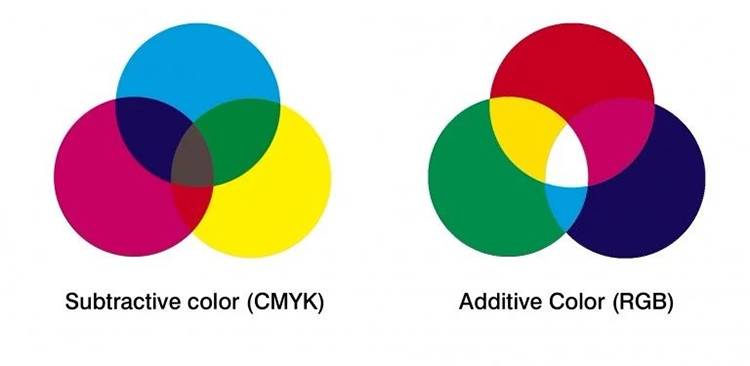What’s CMYK Printing
Not everything we design can be placed under bright lights. Thus, designs intended for printing should be designed in CMYK mode.
The CMYK name comes from the four colors that make up the model: cyan, magenta, yellow, and key. The key represents the color black. Since “B” is occupied by “blue” in the RGB model, the last letter of the word “black” is used instead of the first letter.
Black is used in this color mode because even the purest combination of cyan, magenta, and yellow (all lighter colors) cannot create full black.
CMYK uses subtractive colors, not additive colors. Adding colors together in CMYK mode has the opposite effect on the result than RGB; the more colors you add, the result is more darker. Thus, color is removed or subtracted to create a bright effect.
This is because CMYK colors absorb light, meaning more ink results in less light. Combining cyan, magenta, and yellow produces dark brown. The color is not completely removed until the key (black) is added.
CMYK values are measured in percentages. For example, to make the CMYK color white, you would enter these values into your design software:
C: 100%
M: 100%
Y: 100%
K: 100%

Most authors know that before designing a design draft that needs to be printed (inkjet and printed). You need to use CMYK colors to ensure that there is no big color difference between the design draft and the printed one.
So CMYK printing is widely used in the traditional printing industry, including books, magazines, and brochures. The process involves laying down layers of ink in the four colors, which are absorbed by the paper, resulting in the final printed image. The use of black ink (Key) helps enhance contrast and create more depth in the printed materials.
What’s RGB Printing
RGB is an additive color model primarily used for electronic displays, such as computer screens, televisions, and digital projectors. It combines three primary colors – Red, Green, and Blue – to produce a wide spectrum of colors.
Unlike CMYK, RGB values are represented as numerical values ranging from 0 to 255 for each primary color. That means that each of the three colors (red, green, and blue) has 256 levels that can be combined together to fall on the spectrum between black and white Create color. This means there are over 16 million possible colors in the RGB color model. That’s a lot of options.
For example, the RGB value for black is:
R: 0
G: 0
B: 0
This means there is 0% red light, 0% green light, and 0% blue light. In other words, a complete lack of light, resulting in black.
If need to create white, you should enter:
R: 255
G: 255
B: 255
This is the highest possible value for each color, which means that red, green, and blue light have a brightness of 100%, resulting in the maximum presence of light: white.

RGB printing is primarily used for digital media and online platforms, including web design, social media graphics, and digital artwork. As electronic displays emit light, RGB colors are created by adding light in different intensities, resulting in vibrant and bright visuals.
Difference Between Printing RGB and CMYK
The main difference between RGB and CMYK printing lies in their color representation and application. RGB is used for digital displays, while CMYK is used for printing on physical surfaces. RGB colors are created by adding light, whereas CMYK colors are produced by subtracting light.
In addition, we all know that the RGB value ranges from 0 to 255, which means there are 256 levels and a total of three RGB colors. So in theory, the total number of RGB colors is 256³=16,777,216. The CMYK value ranges from 0 to 100, with only 101 levels. There are only three CMY colors in total, plus a special K. So in theory, the total number of CMY colors is 101³+101=1,030,402. The difference between 16,777,216 and 1,030,402 is more than 16 times.
RGB is capable of reproducing a wider gamut of colors, especially in the vibrant and bright spectrum. However, CMYK is more suitable for achieving accurate and consistent color reproduction in printing. RGB colors often appear differently when printed in CMYK, as the color gamut of CMYK is narrower.
When to Use CMYK Printing
CMYK printing is the preferred choice when it comes to traditional printing methods, such as offset printing and digital printing. It is suitable for materials that will be physically printed, such as books, catalogs, flyers, posters, and packaging. CMYK ensures accurate color representation and consistency across different printing devices.
When preparing files for CMYK printing, it is crucial to work in the CMYK color mode from the start to avoid any unexpected color shifts. Converting RGB files to CMYK can result in a loss of color accuracy and vibrancy. It is recommended to consult with professional printers or graphic designers experienced in CMYK printing for optimal results.
When to Use RGB Printing
RGB printing is primarily used for digital media and online platforms. It is ideal for creating visuals that will be displayed on electronic screens, such as websites, social media graphics, and digital presentations. RGB colors appear vibrant and bright on screens due to the additive nature of light emissions.
When designing for RGB printing, it is important to consider the limitations of the CMYK color gamut. Certain RGB colors may not be achievable in CMYK, resulting in a shift in color appearance. It is advisable to preview designs in CMYK or consult with professional printers to ensure the closest possible color match when printing RGB designs.
CMYK VS RGB: Which is Better for Printing
The choice between CMYK and RGB printing depends on the specific requirements of the printing project. CMYK printing is better suited for achieving accurate and consistent color reproduction in physical printed materials. It is the industry standard for traditional printing methods and ensures predictable color outcomes.
On the other hand, RGB printing excels in creating vibrant and eye-catching visuals for digital platforms. It offers a wider color gamut and is ideal for designs that will be displayed on electronic screens. RGB printing is commonly used in web design, social media graphics, and digital artwork.
To determine which option is better for your printing needs, consider the intended medium and purpose of the design. If the design will be printed physically, CMYK printing is recommended. If it will only be displayed digitally, RGB printing is the way to go.
How to Transfer RGB to CMYK
When transferring RGB designs to CMYK for printing, it is crucial to manage the color conversion process effectively to minimize any unexpected changes in color appearance. Here are some steps to guide you in transferring RGB to CMYK:
Start by creating a backup copy of your RGB design file to preserve the original colors.
Convert the color mode of the file to CMYK. Most graphic design software, such as Adobe Photoshop and Illustrator, provide options to change the color mode.
Adjust the colors as needed to achieve the desired appearance in CMYK. Certain colors may appear differently in CMYK, so it is important to make adjustments accordingly.
Preview the design in CMYK mode to ensure the colors match your expectations. This step is crucial to avoid any surprises during the printing process.
Save the file in a suitable format for printing, such as PDF or TIFF, while maintaining the CMYK color mode.
Following these steps will help ensure a smoother transition from RGB to CMYK and minimize any potential color discrepancies in the final printed output.
Conclusion
Both CMYK and RGB printing have their respective applications and advantages. CMYK is the go-to choice for traditional printing methods, providing accurate and consistent color reproduction. RGB, on the other hand, excels in creating vibrant visuals for digital platforms.
Understanding the differences between CMYK and RGB, as well as their appropriate uses, is essential for achieving the desired results in printing. If you are working with Chinese printers, being knowledgeable about color models will help you communicate your requirements effectively and ensure the best possible outcome for your printing projects.



